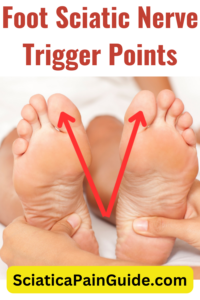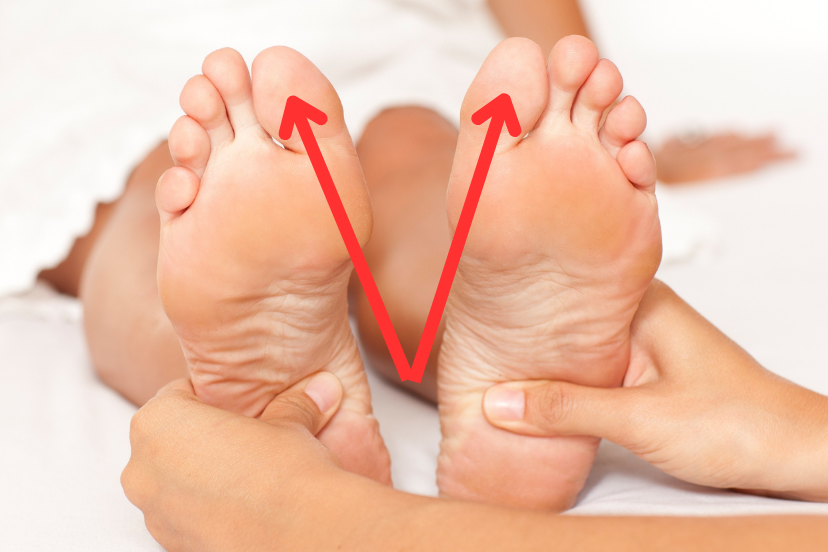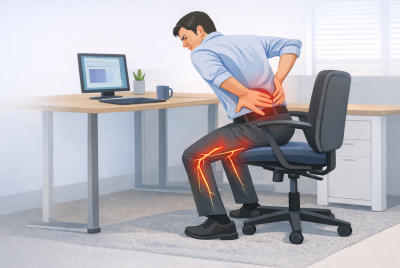Foot Sciatic Nerve Trigger Points
Discover how foot sciatic nerve trigger points can cause pain and learn effective ways to find relief. Explore expert insights now! As a researcher and advisor on sciatica, I understand the impact of foot sciatic nerve trigger points on daily life. If you’re experiencing foot pain or discomfort that radiates from the lower back, down the leg, and into the foot, you may be dealing with trigger points in the sciatic nerve. In this article, I will provide helpful suggestions and explain the reasons behind them to assist you in managing and alleviating the symptoms associated with foot sciatic nerve trigger points.
Understanding The Sciatic Nerve Pain
The sciatic nerve is the longest nerve in the human body, running from the lower back through the buttocks and down the back of each leg. It is crucial in transmitting sensory and motor signals to and from the lower limbs. When the sciatic nerve becomes compressed or irritated, it can lead to a condition known as sciatica, which is characterized by pain, tingling, and numbness in the leg and foot.
Symptoms Of Sciatica
Sciatica refers to the pain that radiates along the path of the sciatic nerve, typically from the lower back down through the buttocks and legs. The symptoms of sciatica are often caused by compression or irritation of the nerve roots that form the sciatic nerve. Common signs include sharp, shooting pain, numbness, tingling sensations, and muscle weakness in the affected leg. The pain can vary in intensity and may worsen with prolonged sitting, sneezing, or coughing. In severe cases, individuals may experience difficulty in walking or controlling their leg movements. Seeking medical attention is crucial for an accurate diagnosis and appropriate treatment to relieve sciatic pain and address the underlying cause.
What Are Trigger Points?
Trigger points are hypersensitive knots or tight bands of muscle fibers that can develop in various body parts, including the back, buttocks, and legs. When trigger points form along the pathway of the sciatic nerve, they can cause referred pain that extends into the foot. These trigger points can be caused by muscle overuse, poor posture, muscle imbalances, or direct injury.
Can You Get Sciatic Nerve In Your Foot?
You cannot get sciatic nerve in your foot, but sciatica can cause pain, tingling, or numbness that radiates from the lower back and travels down the leg to the foot. The sciatic nerve, originating in the lower spine, branches down each leg. Compressed or irritated, it can trigger symptoms extending to the foot. Treatment often involves addressing the underlying issue in the back to alleviate foot symptoms.
Foot Sciatic Nerve Trigger Points Explained
Foot sciatic nerve trigger points are those that specifically affect the foot. These trigger points can develop in the lower back, buttocks, or thigh muscles and send pain signals down the leg, ultimately reaching the foot. The pain may vary in intensity, ranging from a mild ache to sharp, shooting sensations.
Understanding Foot Sciatic Nerve Trigger Points
Sciatic Nerve Trigger Points
Symptoms Of Foot Sciatic Trigger Points
The symptoms of foot sciatic nerve trigger points often include pain or discomfort in the foot, which may be accompanied by other sensations such as tingling, numbness, or a pins-and-needles sensation. The pain may worsen with activity, prolonged sitting, or specific movements that involve the lower back or leg.
Why Foot Trigger Points Matter
Trigger points are tender spots in muscles that cause pain when pressed. In the context of the sciatic nerve, they can become problematic when they cause referred pain down the leg and into the foot.
Symptoms To Look Out For
There are two major symptoms to be wary of:
- Pain Patterns: If you notice a sharp, searing pain radiating from your lower back down to your foot, that’s a classic sign.
- Tingling or Numbness: This feels like pins and needles in your foot. Remember that time your foot ‘fell asleep’? It’s kind of like that, but not as fun.
Causes Of Foot Trigger Points
Foot sciatic nerve trigger points can be caused by various factors. Some common causes include muscle imbalances, prolonged sitting or standing, repetitive motions, poor posture, spinal misalignment, or direct trauma to the lower back or leg. It’s essential to identify the underlying cause to effectively manage and prevent the recurrence of trigger points.
Diagnosing Foot Trigger Points
To diagnose foot sciatic nerve trigger points, it is recommended to consult with a healthcare professional, such as a physical therapist or a chiropractor. They will perform a thorough examination, review your medical history, and may conduct additional tests, such as imaging or nerve conduction studies, to confirm the presence of trigger points and rule out other underlying conditions.
Treating Foot Sciatic Trigger Points
Managing foot sciatic nerve trigger points involves a comprehensive approach that combines self-care strategies, professional interventions, and lifestyle modifications. Let’s explore some of the treatment options that can help alleviate the symptoms and promote healing.
Self-Care And Home Remedies
In mild cases, self-care and home remedies can play a significant role in relieving foot sciatic nerve trigger points. Applying ice packs or heat pads, practicing good posture, maintaining a healthy weight, and avoiding activities that exacerbate the pain can provide relief. Additionally, incorporating stress-reducing techniques, such as mindfulness or yoga, can help relax the muscles and reduce trigger point activity.
Stretching And Exercise
Engaging in specific stretching and strengthening exercises can help improve muscle flexibility, correct imbalances, and alleviate foot sciatic nerve trigger points. Targeted exercises for the lower back, hips, and legs, such as gentle stretches, yoga poses, or low-impact activities like swimming or walking, can be beneficial. However, it’s crucial to consult with a healthcare professional before starting any exercise program to ensure it suits your individual needs.
Massage And Trigger Point Therapy
Massage and trigger point therapy can directly target and release trigger points in the affected muscles. Skilled massage therapists or physical therapists can apply pressure techniques to alleviate muscle tension and promote relaxation. Trigger point therapy may involve deep tissue massage, myofascial release, or dry needling, depending on the severity and location of the trigger points.
Trigger Point Sciatica
Heat And Cold Therapy
Heat and cold therapy can relieve temporary pain and reduce inflammation associated with foot sciatic nerve trigger points. Applying a hot compress or warm bath can help relax the muscles and increase blood flow to the affected area. Conversely, ice packs or cold compresses can numb the area and reduce swelling. It’s important to use heat or cold therapy cautiously and follow the recommended time guidelines.
Medications And Medical Interventions
In more severe cases, medications and medical interventions may be necessary to manage foot sciatic nerve trigger points. Nonsteroidal anti-inflammatory drugs (NSAIDs) can help alleviate pain and reduce inflammation. In some situations, corticosteroid injections may be administered to provide localized pain relief. However, these interventions should be discussed with a healthcare professional to weigh the benefits and potential risks.
Lifestyle Changes And Prevention
Preventing the occurrence or recurrence of foot sciatic nerve trigger points involves making specific lifestyle changes. Maintaining good posture, practicing proper body mechanics during physical activities, engaging in regular exercise, managing stress levels, and incorporating ergonomic modifications in the workplace can all contribute to preventing trigger point formation.
Pay Attention To Pain Response
Stretching can be an effective strategy for managing foot sciatic nerve trigger points, but it’s important to approach it cautiously and properly. While stretching is generally beneficial, certain situations may worsen the symptoms or discomfort associated with trigger points.
Here are some considerations:
- Gentle and Gradual Approach: When stretching to alleviate foot sciatic nerve trigger points, it’s important to start with gentle stretches and gradually increase the intensity and duration over time. Avoid sudden, forceful stretching that may cause additional strain on the affected muscles and nerves.
- Avoid Overstretching: Overstretching can potentially exacerbate trigger points and lead to muscle strain. It’s essential to find a balance between stretching to relieve tension and avoiding excessive strain on the muscles and nerves. Listen to your body and respect its limits.
- Modify Stretching Positions: Different stretching positions may affect them differently. It’s advisable to work with a healthcare professional, such as a physical therapist, who can guide you in identifying stretches that target the specific muscles involved while minimizing any aggravation to the trigger points.
- Pay Attention to Pain Response: While some discomfort or mild stretching sensations during stretching can be normal, it’s important to differentiate between normal and pain that worsens or radiates. If a stretch consistently triggers sharp or intense pain, it’s best to discontinue it and consult a healthcare professional.
- Individualized Approach: Each person’s condition and trigger points may vary. What works for one person may not be suitable for another. Therefore, working with a healthcare professional who can assess your situation, guide appropriate stretches, and monitor your progress is crucial.
Recovery And Healing Process
Can Foot Sciatic Nerve Trigger Points Heal On Their Own?
The foot has the potential to heal on its own, but the healing process can vary from person to person. Sometimes, trigger points may be resolved with rest, self-care practices, and time.
However, it’s important to note that not all trigger points will resolve without intervention, and some may persist or even worsen over time.
Various factors can influence the healing process, such as the severity of the trigger points, underlying muscle imbalances, lifestyle habits, and individual response to treatment.
Mild trigger points that are not chronically activated may have a higher likelihood of resolving independently. However, if trigger points persist or cause persistent pain, seeking professional guidance for appropriate management is advisable.
Self-Care Practices For Healing Process
It’s worth mentioning that self-care practices, such as stretching, applying heat or cold therapy, and practicing good posture, can aid in the healing process and provide relief. Additionally, engaging in regular exercise, maintaining a healthy lifestyle, and managing stress levels can contribute to the healing and prevention of sciatic nerve.
If you are experiencing symptoms that persist or worsen despite self-care measures, consulting with a healthcare professional, such as a physical therapist, chiropractor, or physician, is recommended. They can evaluate your condition, diagnose it correctly, and recommend appropriate treatment options to help facilitate healing and alleviate the symptoms.
Remember, seeking professional guidance ensures you receive individualized care and tailored treatment plans based on your needs and circumstances.
How Long Does It Take To Recover From Foot Sciatic Nerve Trigger Points?
The recovery duration can vary depending on several factors, including the severity of the trigger points, individual response to treatment, and adherence to recommended therapies. While providing an exact timeframe is challenging as each person’s situation is unique, I can offer some general insights.
In many cases, with appropriate treatment and consistent self-care practices, individuals can experience noticeable improvement within a few weeks to a couple of months. However, it’s important to keep in mind that complete recovery may take longer for some individuals, especially if the trigger points are chronic or deeply ingrained.
Recovery Process And Approach
The recovery process typically involves a multifaceted approach that includes self-care strategies, professional interventions, and lifestyle modifications. Consistently following a prescribed treatment plan, which may include exercises, stretches, and targeted therapies, is crucial for promoting healing and resolving trigger points.
However, it’s important to note that trigger points can be complex, and their resolution may not always be linear. It’s possible to experience fluctuations in symptoms during the recovery process. Some individuals may find their symptoms improve steadily, while others may experience temporary setbacks or periods of slower progress.
It’s essential to work closely with a healthcare professional, such as a physical therapist, chiropractor, or physician, who can provide personalized guidance and monitor your progress. They can assess your specific condition, track your response to treatment, and make any necessary adjustments to the treatment plan to ensure optimal recovery.
How Do You Fix A Sciatic Nerve In Your Foot
To address sciatic nerve pain radiating to your foot, first consult a healthcare professional for an accurate diagnosis and tailored treatment plan. Physical therapy often helps strengthen the back and improve posture, which can alleviate nerve compression. Over-the-counter anti-inflammatory medications may reduce pain and inflammation. Corticosteroid injections sometimes offer temporary relief from pain. In severe cases, surgical intervention like a microdiscectomy or laminectomy may be necessary to relieve sciatic nerve pressure. Exercises targeting the lower back can also help in the long term. Always consult a medical professional for a comprehensive treatment strategy tailored to your condition.
Frequently Asked Questions (FAQs)
Is sciatica permanent?
Most people recover fully from sciatica with the right treatments and preventive measures.
Can shoes affect sciatica?
Yes, wearing unsupportive footwear can exacerbate symptoms. Always opt for comfortable, supportive shoes.
Do hot or cold packs help with sciatica?
Both can help. Cold packs reduce inflammation, while hot packs relax tense muscles.
Can exercise make sciatica worse?
It depends on the exercise. While some exercises can help alleviate symptoms, others, if not done correctly, can make things worse.
Is there a pressure point for sciatic nerve pain?
Yes, the GB30 acupressure point targets sciatic nerve pain effectively. Located near the hip joint, halfway between the top of the hip bone and the base of the spine, applying firm pressure to GB30 can relieve sciatica symptoms.
How long does it usually take for sciatica to go away?
The duration can vary. Some might take a few weeks, while others may take several months. Consistent treatment and preventive measures can speed up recovery.
Conclusion
Foot sciatic nerve trigger points can cause significant discomfort and impact daily life. By understanding the causes, symptoms, and available treatment options, you can take proactive steps to manage and alleviate the symptoms associated with these trigger points. Remember, seeking professional advice, practicing self-care, and adopting a holistic approach are key to effectively managing foot sciatic nerve trigger points and improving overall well-being.
Disclaimer
Please note that this article should not replace professional medical advice. Consult a healthcare professional for an accurate diagnosis and tailored treatment plan.
👉 Explore more:





